How To Choose a Chef's Knife
If you could have only one good knife in your kitchen, the right chef’s knife is the one to own. All knives can cut, but a good chef’s knife does that plus more. Consider it as an extension of your hand.
By Pamela Killeen
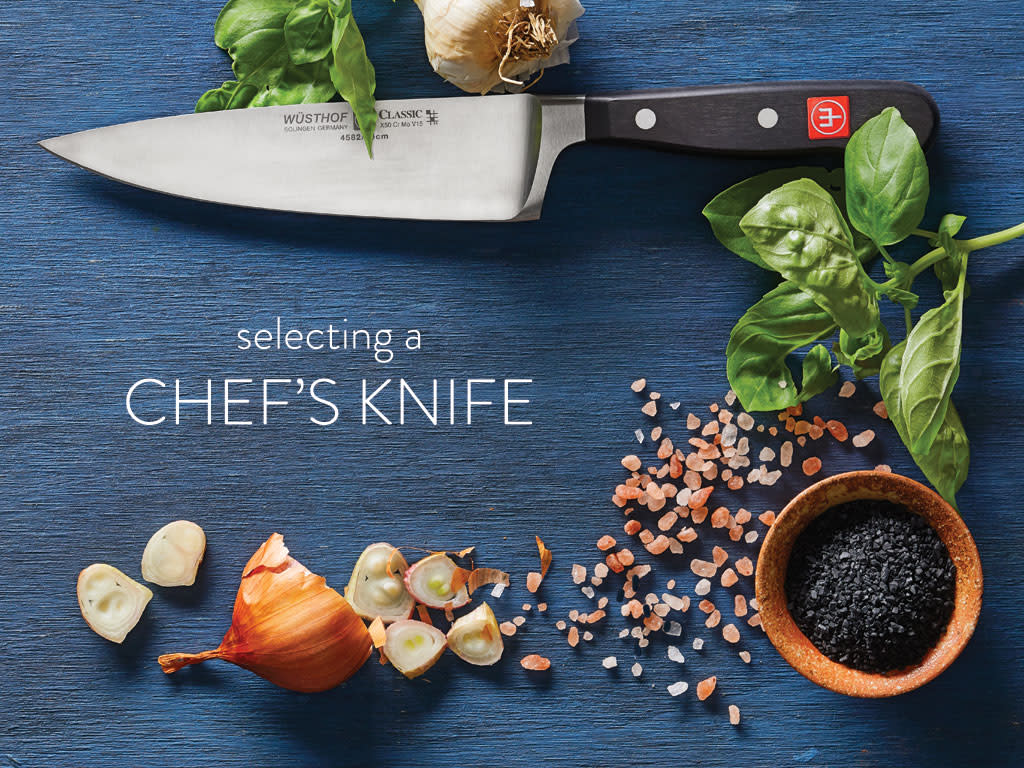
A KNIFE WITH MANY PURPOSES
Just the name alone implies its importance: chef’s knife. While most knives are single-purpose, the chef’s knife is truly versatile. Its primary responsibility is both heavy and light chopping. The mere shape and strength of the blade makes it perfect for all types of cutting. Its heavy weight lets you easily cut through meats, tougher vegetables, and even some small bones. The slightly curved blade allows you to rock the knife back and forth for light chopping and mincing. For rapid slicing, which requires long continuous cuts, the blade begins to straighten out towards the tip.
BEYOND CHOPPPING — WHAT MAKES A CHEF'S KNIFE SO USEFUL
The chef’s knife does much more than just slice and chop. It can perform as a hammer. Using the flat side of the blade, place it on top of a whole head of garlic. With a sharp rap of your hand, hit the blade, and the cloves will separate. Use the same technique to hit the individual cloves and split the skin for peeling. The chef’s knife can also mince and mash. Again by hitting the flat side of the knife, you can crush garlic, ginger, and other seasonings. We think of a chef’s knife as an extension of one’s hand, from cutting to peeling to mashing. It can even scoop up the food you are cutting. The only tool more versatile in the kitchen is your hands.
Chef's Knife Tips

The chef’s knife is used primarily for
chopping. Using the very tip of the
knife, you can dice things like shallots.
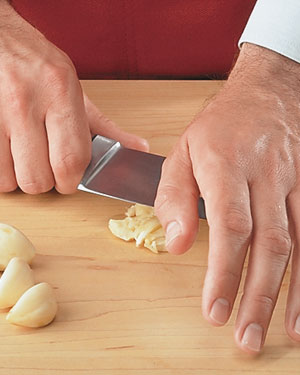
Use the wide flat part of the blade as a
hammer. With a sharp rap of your hand,
garlic and ginger are easily crushed.
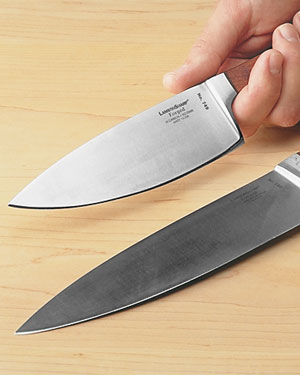
The curved shape of the blade not only
lets you slice, but allows you to rock over
food for chopping, dicing, and mincing.
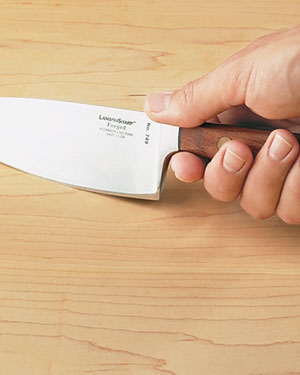
You need plenty of clearance for your
knuckles when cutting. Note the space
between the knuckles and the board.
CHEF'S KNIFE CONSTRUCTION
The key to choosing a good chef’s knife is quality — consider the following:
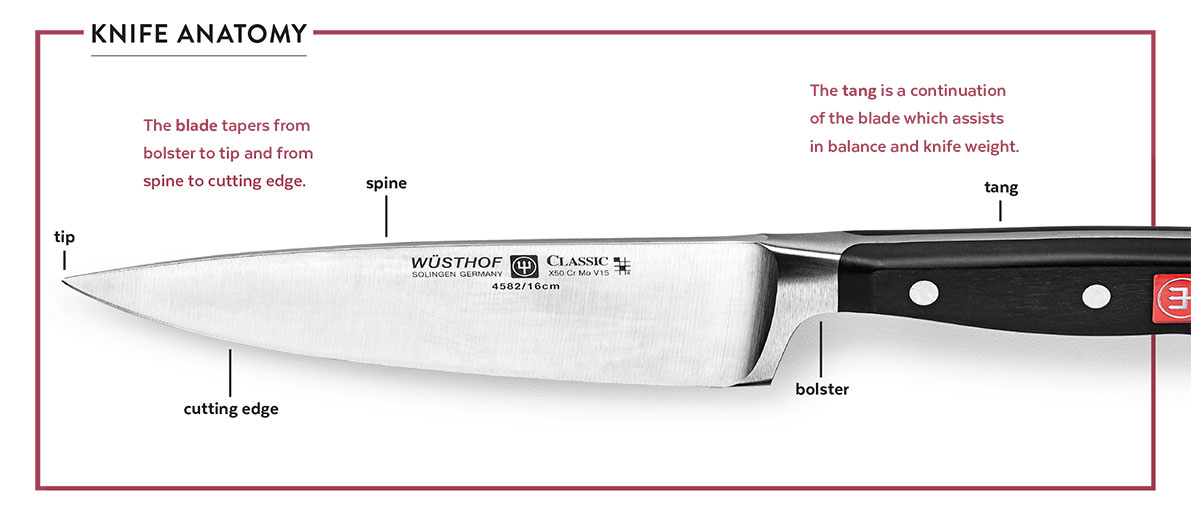
Handle
Grip the handle before selecting a knife based simply on looks. While the material of the handle is important, we think the way it feels in your hand is just as important. A good grip will prevent cramping and fatigue.
Wood: Wooden handles tend to repel oil and grease, making them better than plastic for gripping. Also, some studies have shown that wood is more hygienic than plastic. Wood in cutting boards and handles contain specific enzymes that can fight bacteria. If you want wooden handles, rosewood or a resin-impregnated wood is one of the best choices. Rosewood is both attractive and durable because of its extremely dense grain.
Plastic: The benefit of plastic handles is that they’re molded to fit the shape of your hand. But one major problem we’ve noticed with them is that grease stays on the surface. This can be a hazard if the knife gets wet and residual oils float on top of the handle.
Tang
The tang is the continuation of the blade into the handle. The bigger the tang, the better the knife.
Full Tang: A full tang extends the “full” length and shape of the handle. We prefer a knife with a full tang because of its durability and weight. It’s easy to tell a full tang. The wooden handles will be in two separate pieces. Between the two handles, you’ll be able to see the metal tang taking on the exact shape of the handle. The wooden handles are attached to the tang using rivets. Just be sure that the rivets are smooth and flush against the handles.
Partial Tang: A partial tang extends only halfway back into the handle. It’s the weakest of the tangs and is totally covered by the handle.
Rat-Tail Tang: The rat-tail tang is long, thin, and narrow. Like the full tang, it extends the length of the handle, but it’s less durable. It’s usually found in slicing and boning knives when agility is needed more than strength.
Bolster
The bolster is the wide shoulder between the handle and the blade. All good forged knives have a wide, heavy bolster which adds needed weight and control. It also provides a comfortable place to press your index finger when holding the knife.
Blade
Blades are made from several types of steel, but the best and most practical is a high-carbon “no-stain steel.” This special cutlery steel combines the appearance and durability of stainless with some of the sharpening capabilities of carbon steels. The higher carbon content allows the blade to easily take a sharp edge while the stainless steel prevents the blade from discoloration and rusting.
The most desirable blades are taper ground, indicating that the blade has been forged from a single piece of metal. You can tell this by seeing the blade gradually taper from thick to thin, both from the spine to the cutting edge and from the bolster to the tip, see the picture, above.
We like a thicker spine on the blade. This is especially the case when one is doing a lot of cutting, because we tend to press our thumbs where the spine meets the bolster. Stamped blades begin to cut into your skin causing some discomfort.
The Most Important Characteristic in a Chef's Knife
While there are many characteristics to consider when purchasing a chef's knife, the most important is feel. If it doesn’t feel comfortable in your hand, you simply won’t use it.
A good chef’s knife is an investment that, with proper care, should last a lifetime.
And now that you know what to look for in a knife, check out this refresher on How to Cut an Onion like a Chef and put your blade to good use.
Product Recommendations
Interested in cooking? Need some supplies?
Check out some of the tools we like. All products featured on Cuisine at Home are independently selected by our editors; we may earn an affiliate commission from qualifying purchases through our links.